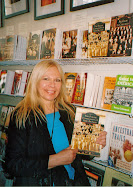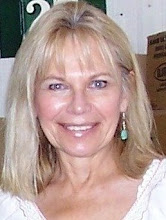There is a lot to be said about all the DNA tests my family members and I have taken over the past three years. I am certain of this from all the probing questions and insightful answers that other people post daily on the DNA-Newbie list. They are analyzing shared cMs, mulling relationship ranges, discussing STRs and SNPs …
Mutations and matches and markers, oh my!
I'm clueless.
Not entirely clueless. I kinda sorta get the really basic basics here, just like I kinda sorta get the precession of the equinoxes, and I am committed to learning as much as my boggled little right brain can hold because DNA completely fascinates me. I want to understand as much as I possibly can about what these tests reveal about my family's past.
I also want to share some of our FamilyTreeDNA findings, and expand upon my prior post's quick list identifying my two grandfathers' Y-DNA haplogroups and my two grandmothers' mtDNA haplogroups. It may seem like I'm overthinking things, but I've been a bit hung up on how to do this. Obviously, I'm ill-equipped to offer a presentation that is even remotely scientific. (I prefer not to make a complete fool of myself on The Internet, Where Everything You Post Remains Online Forever.)
If you want to know more about how, when, and where any of our particular haplogroups fit into tens of thousands of years of human migration, you would do well do simply Google them, for starters; there are many resources online.
I'm keeping it simple: an overview of the tests, a few screen shots, a couple of observations, a couple of disclaimers, and some relevant names, dates, and places from my family tree. All of the villages and parishes referred to are in the Lida region of western Belarus. Szczuczyn is about 30 miles east of Grodno; Radun is about 60 miles farther east, and about 45 miles south of Vilnius, Lithuania. Unlike the men, the women take on new surnames in each generation as the result of marriage. I mention those names in my eternal hope of connecting with long-lost relatives through this blog.
Paternal ancestry
Grandfather Julian Prokopowicz — Y-DNA haplogroup N1c1 (also known as N-M231)
I know nothing about my paternal great-grandfather, Kazimierz Prokopowicz. After 17 years of research, I have not found even one single record documenting his life. No surprise, then, that I have been so interested in gleaning what information I can from the Y-DNA he passed down to his male descendants. Thanks to my paternal uncle's willingness to be tested, I have learned at least that my paternal Prokopowicz men belong to haplogroup N1c1, which is widely found in northern Europe among the western Siberian Yakuts and Nenets, the Finnic and Baltic peoples, the Saami, and some Russians.
The surnames I see among my uncle's 230 Y-DNA matches are overwhelmingly Lithuanian, Polish, Russian, Finnish, and Latvian. The closest matches report geographic roots in Lithuania, sweeping southward from Vilnius into the Lida region of Belarus. Some bear surnames that I recognize from the parish records of Radun (where my grandfather was born) and Nacza and Ejszyszki (where several Prokopowicz families are documented from the late 1700s on).
These matches are not recent; the likelihood of sharing a common male ancestor within the last 4 generations is about 61 percent; within the last 8 generations, about 85 percent; and within 12 generations, about 94 percent. Estimating 4 generations per century, those percentages suggest a likelihood of connection sometime in the 1700s.
At 24 generations, or 600 years, the probability of connection jumps to 99.66 percent. Does this mean that my paternal Prokopowicz ancestor was living somewhere in the Wilno/Vilnius region circa 1400? Could it mean that he was part of a tribe or group that migrated there in that time frame? Could it mean something else entirely? I don't know. I would dearly love to test some male Prokopowiczes with roots in the village of Poleckiszki or okolica Mongieliszki, two locations (both on the Lithuania-Belarus border) where I've found numerous Prokopowicz records. Or Turgeliai, Lithuania (in Polish, Turgiele), another Prokopowicz village area that I have not researched at all.
Because the text box accompanying the white push-pin icon representing my uncle would have covered most of Lithuania and Latvia on the map of his matches, I removed it. Imagine it in the northwest corner of Belarus.
Grandmother Anna Blaszko — mtDNA haplogroup T2b
While Y-DNA can suggest relationships within a few hundred years, mitochondrial DNA is more an indication of "deep ancestry" and human migration over thousands of years. It lends itself to "Daughters of Eve" analysis more than to hopes of discovering a cousin (though the latter is possible too). The main insight I have gained from my family's two mtDNA tests is that my grandmothers were descended from two different tribes of women. (If you had known my grandmothers, that would actually come as no surprise.)
Since it was administered in April 2013, the FTDNA mtHVR2toMega test (HVR1, HVR2, Coding Region) has yielded 228 matches for my paternal grandmother's T2b mitochondrial DNA. There are 45 matches at zero steps removed, 67 at 1 step (a prominent African American genealogist and university professor among them), 70 at 2 steps, and 46 at 3 steps removed. Frankly, I don't know what "steps" mean (some sort of mutations, maybe).
At any rate, among the 27 closest matches who identified their maternal line's country of origin, 6 claim Germany, 4 Ireland, 3 each Finland and England, 2 Switzerland, and 1 each Austria, Estonia, Greece, Netherlands, Norway, Spain, Sweden, the UK, and the US. The screen shot (at right) of the closest matches shows my grandmother's maternal line with a white marker and her few exact matches in red. She appears alone in western Belarus, but that may be the result of fewer people with roots there having done the mtDNA test.
For the record, in my father's mother's family, these are my direct ancestors:
grandmother — Anna Blaszko, born 1895 in Skladance, Radun parish
great-grandmother — Teresa Bowszys, born 1866 in Skladance, Radun parish
great-great-grandmother — Anna Tumielewicz, born circa 1835 in Narkuny, Żyrmuny parish
great-great-great-grandmother — Katarzyna Komięcz, born circa 1806, probably in Gudele, Żyrmuny parish
Maternal ancestry
Grandfather Aleksandr Prokopowicz — Y-DNA haplogroup R1a1 (also known as R-SRY10831.2)
I'm very fortunate and thankful that my cousin agreed to have his Y-DNA tested. He is the only living direct male descendant of my maternal grandfather. Lacking my cousin's willingness, I would have had to seek out a male descendant of one of my great-grandfather Kazimierz's brothers—not an impossible alternative, and one that I hope to pursue in the future, but it seems optimal to test as close to home as possible.
Compared to my other grandparents' same-sex haplogroup tests, this Y-DNA test has a staggering number of results—931. However, only 5 of them match at more than the 12-marker level, and even those are remote. As I interpret the results, any relationship between this Prokopowicz line and its 931 matches is probably no more recent than the year 1400.
My cousin's test results perhaps serve as an example of the fact that R1a1 is a very large, very common Y-DNA haplogroup, which spread from Eurasia to central Europe and Scandinavia thousands of years ago. The countries with the highest frequency of representation in my cousin's matches are Norway, the central European and southern Slavic countries, and Pakistan.
The screen shot shows the countries of origin claimed by men whose Y-DNA test results most closely match my cousin's. A white push-pin icon, barely visible amid the red and orange icons that cover the map of Europe, represents him, and our Prokopowicz line.
I can't elaborate any further here without stepping into scientific territory where I really don't belong. A graphic labeled "R1a1 Clades (by SNP markers)" on the FTDNA R1a1 and Subclades Y-DNA Project-Background page very clearly illustrates the migration time line of the SNP tree (basically, changes in the DNA sequence at specific locations). To see where the Prokopowiczes fit it, trace the green Central and Eastern Europe/Western Asia Z280 section to the far right column tagged Balts that ends in Z661. If I understand my cousin's SNP test results correctly, the Prokopowiczes represent some subsequent mutation there, yet to be identified.
In my mother's father's family, these are my direct male ancestors:
grandfather — Aleksandr Prokopowicz, born 1878 in Kozarezy, Iszczolna parish
great-grandfather — Kazimierz Prokopowicz, born 1845 in Kozarezy, Iszczolna parish
great-great-grandfather — Stefan Prokopowicz, born 1811 in Kozarezy, Iszczolna parish
great-great-great-grandfather — Ludwik Prokopowicz, born circa 1765, probably in Iszczolna parish
great-great-great-great-grandfather — Stefan Prokopowicz, born circa 1730, probably in Iszczolna parish
My research documenting the descendants of my great-great-great-great-grandfather Stefan Prokopowicz is fairly extensive. Each generation was blessed with sons. It would be wonderful to make contact with any current bearers of the Prokopowicz Y-DNA.
Grandmother Stefania Ruscik — mtDNA haplogroup H27
H27 is a very small (very, very small!), fairly recently identified group. My FTDNA mtHVR2toMega test has yielded just 54 results since 2010. Only one match is zero steps removed, hinting vaguely at a possible common maternal ancestor within the time frame of verifiable, paper-trail research. That tester knows little of her maternal ancestry except that her grandmother was from Poland.
The other 53 matches, 1-3 steps removed, comprise a cluster in eastern England, 3 in Finland, and 1-2 each in Ireland, Belgium, the Netherlands, Germany, the Czech Republic, Poland, Norway, Sweden, and Turkey. Looking at continental Europe (excluding Scandinavia), my grandmother's line is actually the farthest east. How the heck did it end up there?!?
These are my direct maternal ancestors:
grandmother — Stefania Ruscik, born 1882 in Gierniki, Szczuczyn parish
great-grandmother — Emilia Nowogrodzki, born 1853 in Kozly, Wasiliszki parish
great-great-grandmother — Krystyna Sobol, born 1821 in Gierniki, Szczuczyn parish
great-great-great-grandmother — Anna Staniejko, born 1799 in Janczuki, Szczuczyn parish
great-great-great-great-grandmother — Theresia Waszczynska, born 1756 in Janczuki, Szczuczyn parish
great-great-great-great-great-grandmother —Anna ?, born probably circa 1730, probably in Szczuczyn parish (or possibly elsewhere)
As the map below illustrates, my maternal H27 mtDNA has only one exact match, somewhere in Poland.
Sunday, July 28, 2013
My grandparents' haplogroups: N1c1 & R1a1 Y-DNA; T2b & H27 mtDNA
Labels:
Blaszko,
Bowszys,
H27,
Iszczolna,
Komięcz,
mtDNA,
N1c1,
Nowogrodzki,
Prokopowicz,
Radun,
Ruscik,
Sobol,
Staniejko,
Szczuczyn,
T2b,
Tumielewicz,
Wasiliszki,
Waszczynska,
Y-DNA,
Żyrmuny
Subscribe to:
Post Comments (Atom)














No comments:
Post a Comment